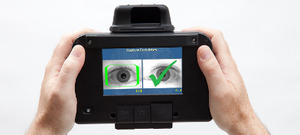The promise, and risks, of battlefield biometrics
Using biometric devices in Afghanistan offers many benefits to coalition forces and to the Afghani themselves in making it easier to separate the good guys from the bad; some worry, however, that this can backfire — as was the case in Rwanda in 1994: identification cards which included photos and tribal affiliations of either Tutsis and Hutus made it easier for Hutu militias to identify the Tutsi and murder them

The HIIDE hand-held biometric authentication device // Source: l1id.com
With a high-capacity storage of up to 22,000 full biometric portfolios (two iris templates, ten fingerprints, a facial image, and biographic data), L-1’s HIIDE Series 4, or Handheld Interagency Identity Detection Equipment, is receiving praise for its functionality and appeal to Afghanis wishing to have proper identification that would distinguish them from suspected terrorist in question.
The HIIDE is the world’s first hand-held tri-biometric system that allows users to enroll and match via any of the three primary biometrics: iris, finger and face. The intuitive user interface makes it easy to enter biographic data to create a comprehensive database on the enrolled subject. The HIIDE provides complete functionality while connected to a host PC or when operating in the field un-tethered.
The featured biometric technology is presently being used in a ring of security checkpoints around Kandahar City in Afghanistan, where Canadian operated bases are also being equipped with it. The enrollment procedure is voluntary and takes approximately six minutes to complete. All the biometric information is sent securely to the database of ISAF, NATO’s International Security Assistance Force.
Winnipeg Free Press features Canadian Warrant Officer Sylvain Ledoux describing the implementation of the HIIDE and the device’s accuracy in discerning potential terrorist threats: “So there’s around 25,000 people in there on the watch list. If there is any match on a bad guy, we’ll find out … When you get an iris match, you do have a match. The iris won’t lie.”
Biometric identification prevents the most simple form of concealment, such as changing one’s name. Unless an Afghani is detained for a suspected crime, biometric enrollment is purely a voluntary process. Ledoux comments further on the appeal of such a simple identification system: “…there are some villages where the people want to join and, in effect, get something like a national identity card that would help clear them of suspicion.”
“The machine can give him a biometric card with the name of his village. So for them, it’s the proof that they are the good guys — that they’ve been checked against the watch list and are good to go.”
The HIIDE provides those active in the field with an almost fail-proof form of identification, but there are still counter-arguments to its implementation.
A DefenseNews article from last year provides a few examples of how biometrics are also being used beside voluntary enrollment:
Electronic Privacy Information Center (EPIC) director, Marc Rotenberg, raised the concern that as “…databases are compiled, the individuals whose information is stored in them have little or no opportunity to see what has been collected or to correct any errors.”
John Sileo, identity theft expert, speaker, and author of Privacy Means Profit (Wiley, August 2010), relates that “…data breaches have and will continue to occur. People must realize that biometric data is no different from any other type of information once entered into a database — the problem is that nobody has proven they can really protect these invaluable assets.”
